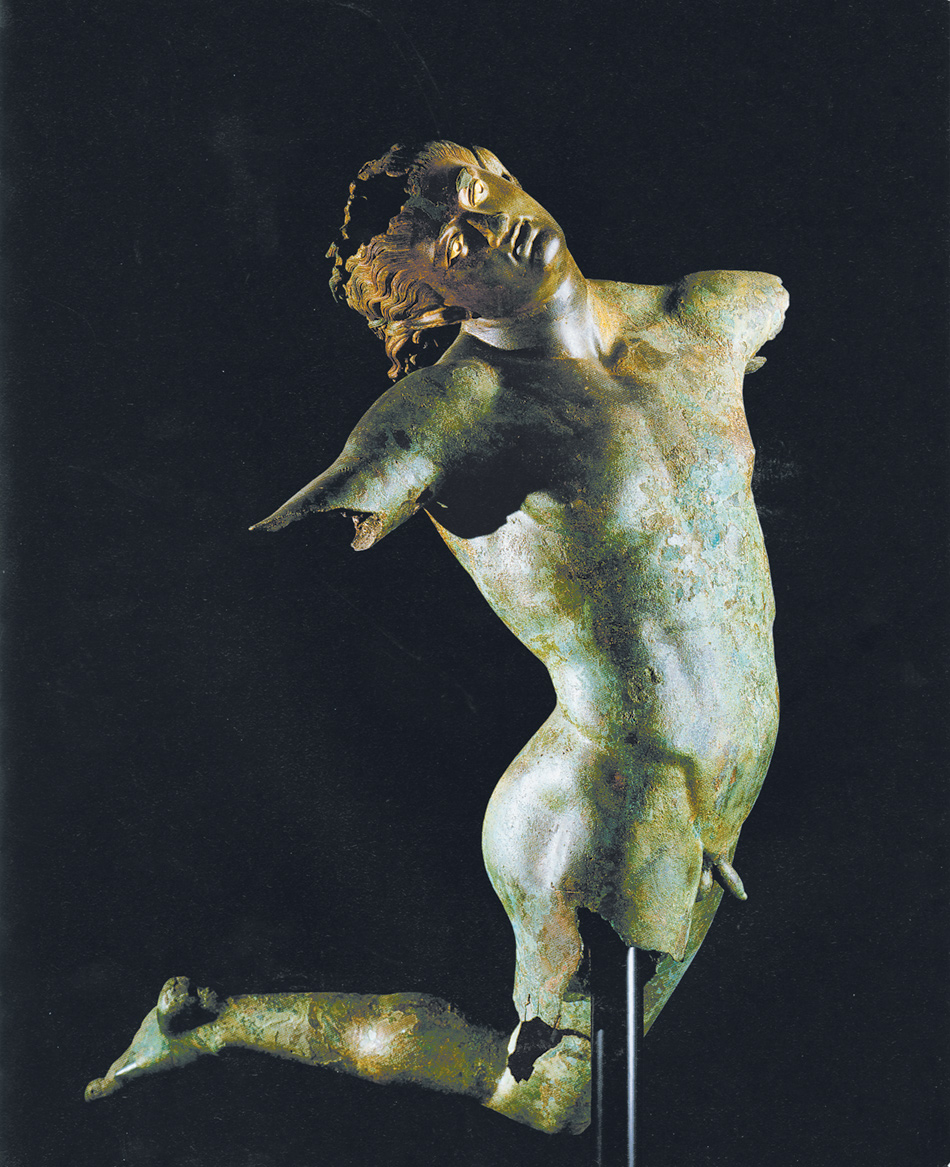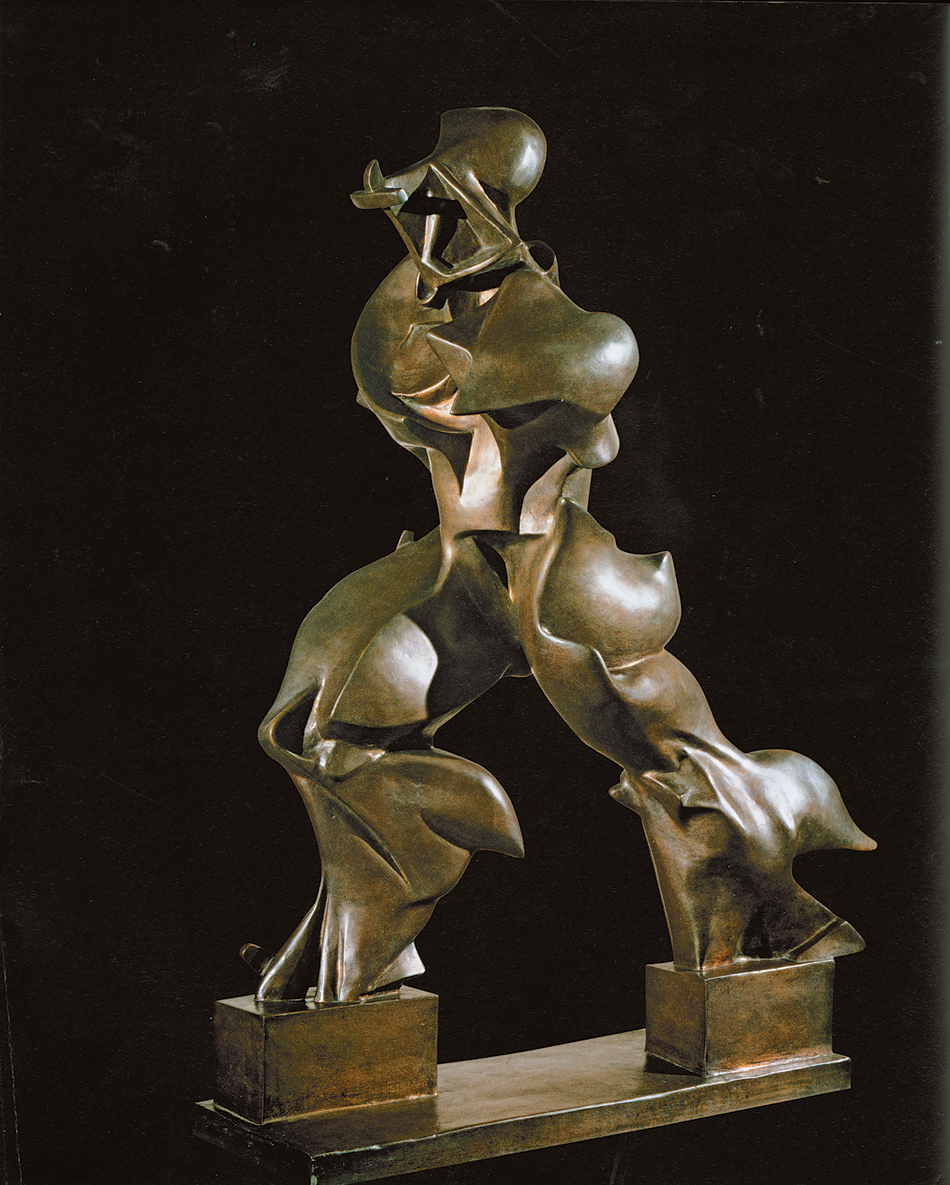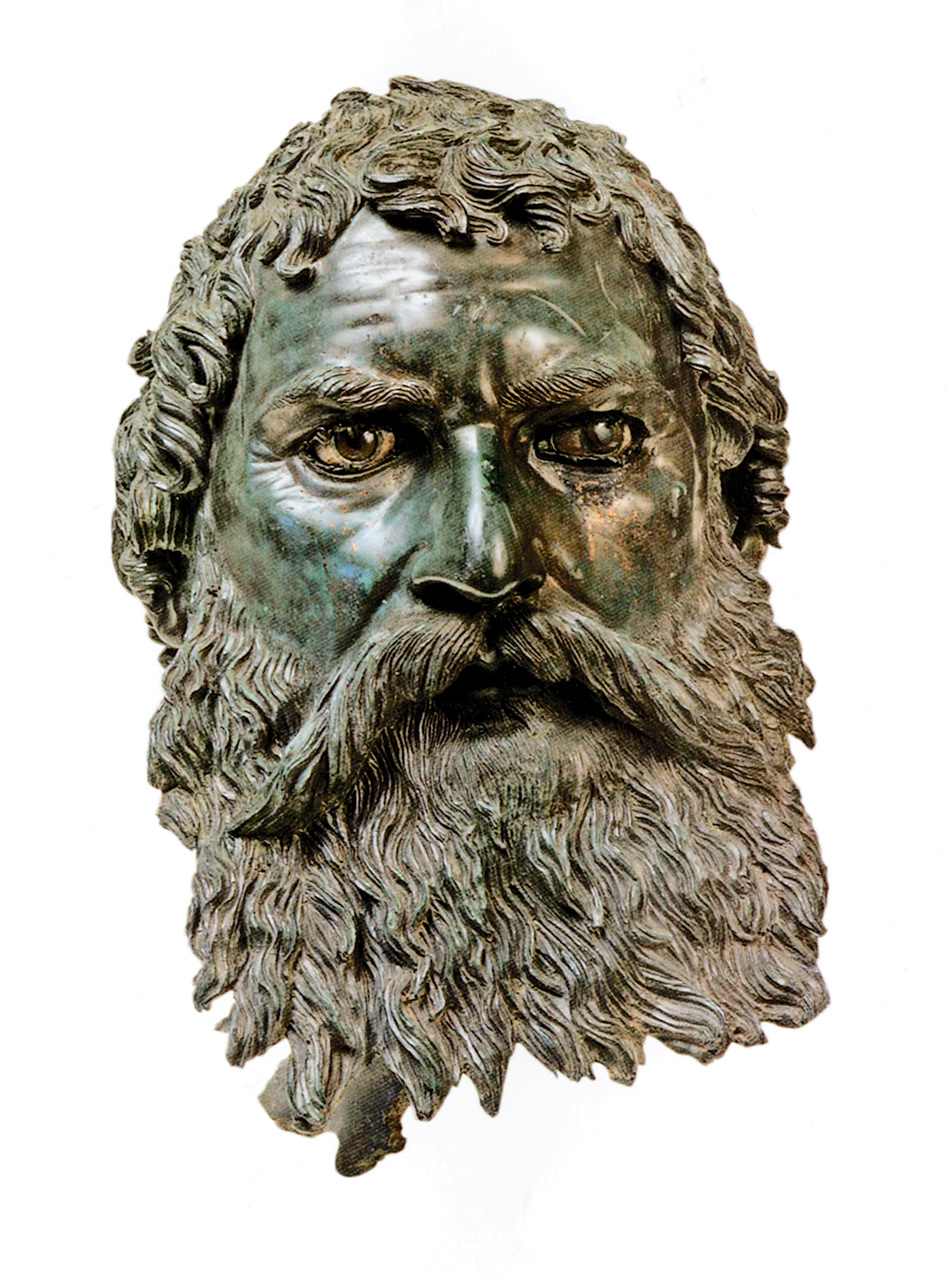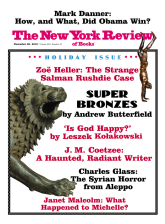This fall the Royal Academy in London has put on one of the most astonishing exhibitions of sculpture ever mounted. Titled simply “Bronze,” the show brings together an abundance of masterworks in bronze and other copper alloys from a dazzling range of cultures and periods. On display are more than 150 pieces, coming from nearly every continent, and made over a span of almost six thousand years. The excitement of the show lies not only in the chance to see so many great works, from prehistoric to contemporary, in a single visit. Gathering in one place outstanding examples from different civilizations, and arranging them by theme rather than culture, the show also allows the viewer to consider some of the common characteristics of sculpture throughout time and all over the world.
Bronze is very different from most materials of sculpture. The other substances commonly used in pre-modern statuary, such as stone, wood, and clay, are natural materials. But bronze is a human product, made by melting copper together with one or more other metals to create an alloy. First devised in the ancient Near East probably sometime early in the fourth millennium BC, the resulting alloy has many advantages over pure copper. It melts at a lower temperature and thus is easier to cast; and it makes an exceptionally hard metal, one that can be worked in fine detail, and keep a sharp edge. It is excellent for tools, weapons, and bells, as well as sculpture.1
Creating a statue in bronze, however, is far more complex than making one in stone, wood, or clay. In those materials, the artist works directly on the final piece (although of course possibly after developing the composition in a series of preliminary studies). A bronze sculpture, on the other hand, usually requires a laborious procedure known as lost-wax casting. There are many steps in the technique, but in essence, the artist must make a model in wax, encase it in a fire-resistant mold, bake out the wax leaving a void in the mold, pour molten metal into this void, let the bronze cool and harden, break open the mold, and then clean up, chase, and polish the bronze. This is the simplest method. But to save on the great cost and weight of bronze, as well as to ensure that the molten metal would cool at an even temperature and not crack, most statues are cast so that they are hollow inside, and to achieve this requires many additional stages of work.2
The casting process could break down at almost any point. For example, the molten bronze could fail to run through the mold properly, or hot gases produced during the pour could leave holes in the sculpture. Success was far from assured. Indeed, throughout much of history, making a bronze was considered to be akin to wizardry, and even the most technically accomplished sculptures needed reworking and repair after casting.
Given the additional time, cost, and risk, why bother? Because a sculptor can do things in bronze that cannot be done in any other material. Its tensile strength is vastly superior and this makes it possible to create free-standing statues on a much bigger scale in bronze than in stone, wood, or clay. For example, the exhibition catalog mentions an ancient sculpture of the Roman emperor Nero that was thirty meters tall; this was roughly six times higher than Michelangelo’s David, one of the largest Renaissance marbles.
The strength of bronze also allows the artist to pose the figure with far greater freedom. In a statue in stone, wood, or clay the limbs usually must be placed close to the body; otherwise they will break off. Moreover, drilling through the lower portion of the piece also must be kept to a minimum, or the statue might collapse under its own weight. As a result, statues in those materials often tend to have a blocky appearance, and to be shown in stances with little motion. But a bronze sculpture can be composed so that it depicts a state of vigorous action: running, dancing, fighting, riding, and so forth.
The first work on view in the exhibition is a Dancing Satyr made in Greece in the fourth century BC, possibly by Praxiteles. Although now a fragment, enough survives of this over-life-size figure that it is clear he stood on one leg, with the other leg bent at the knee and kicking up behind him, and the arms fully extended to the sides. In sculpture a pose of such drama and motion can only be achieved in bronze.
The metal has another quality that has been perhaps even more fundamental to its appeal: its supreme durability. Few bronze statues from antiquity survive, but this is only because subsequently they were melted down to reuse the metal for cannons or other tools and weapons. Left alone, bronze will last indefinitely, and this made it especially suited for monuments and other works of art meant to be of timeless significance. This characteristic has long been celebrated. In the Iliad, describing the Shield of Achilles, Homer called its gold and silver elements “valuable” but praised its bronze elements as “weariless.” Horace said that only the greatest poem could be “a monument more lasting than bronze.” Lorenzo de’ Medici wrote of the power of bronze to perpetuate fame.
Advertisement
Different cultures wholly unrelated to one another have independently explored similar capacities of bronze as an artistic medium. As David Ekserdjian, the head curator of the exhibition, states in his essay in the catalog, “For all their cultural specificity, the best individual bronzes do as a rule seem to be uniquely capable of speaking a common language.” To examine both the cultural specificity and the common language of bronze sculptures, Ekserdjian and his collaborators have brought together an extraordinary group of masterpieces from many different periods. The oldest works in the show are a scepter and four other pieces of regalia found in a cave in Nahal Mishmar, Israel, and date from about 3700 BC. The most recent is an untitled mirror piece by the Indian-born British sculptor Anish Kapoor, made earlier this year.
The diversity of cultures, too, is staggering. Not only are there works from major artistic centers in the ancient Near East, Egypt, Nigeria, classical Greece, Renaissance Europe, China, and so on. There are also a refreshing number of pieces from cultures that will be previously unknown to many visitors, such as the Nuragic civilization in present-day Sardinia, the kingdom of Tartessos in present-day Andalusia, and the Ortoquid dynasty of Kharput in what is now Elâzi, in Turkey.
The organizers have made the uncommon decision to arrange the works by theme, rather than region or chronology. The first room presents a breathtaking array of figure sculptures—larger statues ring the space, while the center of the room has cases with small statuettes. Along one wall you see a giant portrait statue of a wealthy Roman official from the first century AD, an ancestral portrait statue made in fourteenth- or fifteenth-century Nigeria, a dynamic blur of an abstract figure by Umberto Boccioni (see below), a wraith in a cage by Alberto Giacometti, and the French nineteenth-century sculptor Aimé-Jules Dalou’s life-size realist sculpture The Great Peasant.
Along the facing wall stand such works as Rodin’s The Age of Bronze, full of pathos and grace, Willem de Kooning’s Clam Digger, shimmering and shifting in the light, and Lorenzo Ghiberti’s towering Saint Stephen, looking majestic and serene. Other works in the room include David Smith’s autobiographical Portrait of a Painter and Giovan Francesco Rustici’s Saint John the Baptist Preaching to a Levite and a Pharisee, a colossal narrative group made for the Baptistery of Florence at the beginning of the sixteenth century, certainly under the influence, and possibly with the help, of Leonardo da Vinci. It is a gathering of masterpieces, the likes of which has never been seen before.
The following two rooms bring together a menagerie of animal statues, bursting with life. The Chimera of Arezzo, possibly the greatest Etruscan sculpture in the world, snarls and roars near the center of the first of these rooms (see illustration on the cover of this issue). The Hellenistic Head of a Horse, a prized possession from Lorenzo de’ Medici’s collection, is also here, as is the life-size ancient Roman Ram that once stood at the gate of the palace of the Hohenstaufen emperor Frederick II. It is not just the sheer quality and the important provenance of the works that are so astounding. It is the diversity of styles as well. The Ram and the Head of a Horse may seem utterly lifelike, but the Chimera is an absolute fantasy, and other pieces in the room include such highly formalized works as the proud Islamic Lion made about 1100, whose torso is so rounded it is almost like a parade balloon, and the sinister and implacable Pair of Leopards from sixteenth-century Benin, nightmarish animals who could eat you up.
The following section of the show is composed of groups of figures, most of them mythic in subject matter. Here too the breadth of material is exhilarating. The earliest work is Chariot of the Sun, a small piece that shows a horse and a celestial disk, gilded on one side only, set atop a spindly six-wheeled cart. Considered a national treasure in Denmark, where this alluring work was found, it probably dates from the middle of the second millennium BC, and was made by a civilization about which virtually nothing is known. At the other end of the room is the most recent bronze group on display, Frederic Remington’s Off the Range (Coming through the Rye), a statuette of cowboys on horseback, cast in 1903; it looks like a still from a western.
Advertisement
Between these extremes of the sacred and the mundane, the inscrutable and the familiar, comes a wildly diverse assortment of pieces, such as a deeply touching Chola statuette of Yashoda Nursing the Infant Krishna, an early Ming gilt bronze of Kepâla-Hevajra dancing in sexual embrace with his consort Nairâtmya, and half a dozen Renaissance and Baroque sculptures of Hercules as a personification of good conquering evil.
The next two rooms, providing a miscellany of “objects,” are the least captivating portion of the show. To be sure, fascinating things are on view, such as ritual vessels from Shang China and the imposing Krodo Altar from the Ottonian empire, a work that is dated around the late eleventh or early twelfth century. The organizers are making an important point: that bronzes are things, not just representations. But few of the works here grip the visitor with the same fascination as those in the other parts of the exhibition.
Just beyond this break in the intensity of the exhibition is a section on relief, and there are so many treasures in this gallery that it is hard to know where to look first. The largest and perhaps most impressive works here are Matisse’s four massive sculptures of Backs. The show is exceptionally well installed and lighted, and many works appear to have more vitality and power than they ever displayed before. This is the case with the Backs, which seem charged with raw energy, as if the figures were struggling to take shape, and emerge from the bronze right in front of your eyes.
In the next room, dedicated to statues of gods, the show achieves another sustained high point of exceptional sublimity. Some of these works, such as the Eleven-headed Avalokiteshvara made in Tibet around 1400, or the eight-armed bodhisattva Maitreya, from tenth-century Cambodia, are visions in bronze—unearthly, graceful, serene. Yet facing them from the other side of the gallery is another work of intense feeling, one wholly different in expressive character: Adriaen de Vries’s life-size Seated Christ from 1607. The physiognomy is heroic and the surface of the metal glistens like gold, but the work depicts the anxious suffering of Jesus during the Passion with such sharp force that it is hard to look at. All these sacred sculptures make you share the feelings they depict.
Yet some of the other images of deities in this room were meant to be no more than emblems of the patrons’ high status and cultural refinement. This is true of the sculptures of classical gods from Renaissance and Baroque Europe on view, such as Peter Flötner’s magnificent Apollo Fountain, made in 1532 for the Guild of Archers in Nuremberg. As the catalog notes, this statue showing the god in a pose reminiscent of the Apollo Belvedere is “one of the supreme achievements” of metalwork from Germany, and “represents a spectacular act of northern obeisance to the classical modes” of Renaissance Italy.
The last room of the show is filled with heads. These include the most startlingly naturalistic work in the entire show, the recently discovered Hellenistic portrait of King Seuthes III of Thrace. Life-size, with a flowing beard and alert, intelligent eyes, this is the only work in the exhibition that looks like it actually might be a miraculous and unmediated translation of the human form directly into bronze. Yet in the same room you also see one of the most stylized transpositions of the actual into the artful I know of, Brancusi’s Danaïde, in which the sculptor has reduced the head of the model to a shape almost as smooth and ovoid as an egg, with just two arcs and a dash to suggest the features of the face.
Some art historians have complained that the arrangement of the works by theme robs the show of scholarly validity; in their view, the exhibition is nothing more than a grab bag of treasures and tells you nothing serious or new. But the mix of periods and styles is surely a huge part of the show’s success. Visitors wander through delighted and amazed by both the diversity and the similarities of the works on view.
Moreover, this mix is crucial to the questions the show provokes about the nature and uses of sculpture, and even about the visual arts in general. Walking through the galleries of the exhibition, I found myself thinking time and again of two major books of twentieth-century scholarship, Ernst Gombrich’s Art and Illusion (1960) and André Malraux’s The Voices of Silence (1951), and specifically about the relationship of naturalism and stylization in representation. Perhaps Gombrich’s sway is not as powerful today as it was a generation ago, yet critics and historians often still assume, as he argued, that making art is fundamentally an empirical and progressive enterprise. No one has put this idea more directly than Gombrich when he wrote in these pages: “The whole history of Western art can thus be seen as an effort in escalation, the surpassing of expectations by a further approximation to realism.”3
Yet in so many of the works in “Bronze,” what you see is that the artist has tried to transform, not simply replicate, the appearances of the natural world. This holds true regardless of the period or culture of the maker. Two alterations are particularly common. One is the change in scale. There are some important exceptions, such as the portrait of Seuthes III and the Seated Christ by Adriaen de Vries, but almost every work in the show is either much larger or much smaller than natural size. This is particularly evident in the first gallery where the giant sculptures at the edges tower over the small statuettes in the center.
Another common change is the purification of form: shapes are simplified, details eliminated. The accidental, transient, and personal are reconfigured according to some ideal. Among the many groupings of objects that exemplify this impulse, perhaps none is more telling than the pairing of an ancient Roman parade mask with the Mask of Obalufon II from the Ife culture in fourteenth- or early- fifteenth-century Nigeria. The latter may be a portrait, but in both cases the features of these heads, intended for use in ceremonial, have been smoothed and rounded.
Nearly every contributor to the catalog comments on how the art they study shows both concern for the actual, and intentional departure from the natural. For example, Ekserdjian writes about medieval works in which “heraldic dignity and a spirit of observation…are magically combined”; Timothy Potts speaks about the “stylized naturalism” of art of the ancient Near East; and Patrick Elliott says that Rodin in his figure statues declared “that artistic representation was not a matter of mimesis, but one of invention.”
Sculpture has often been intended to make a statement of enduring value, and this is perhaps especially true in the “weariless” medium of bronze. Moreover, most of the objects gathered in this show are not merely works of art, but were made as expressions to or about the divine, and they were meant to last forever. They are images of the gods and saints, votives, altars, grave goods, foundation markers, tributes. As such they were intended to substantiate—in both senses of the word, to embody and to give proof of—incorporeal hopes, desires, and beliefs. Sculpture cannot do this work if it is simply mimetic. This is equally true whether the postulates that must be affirmed are about the cosmic or the social order. Hence, the tenth-century Cambodian statue of a bodhisattva has a dome-shaped head resembling a stupa and eight arms for the viewer to contemplate, and the first-century Roman sculpture of an important official is over-life-size, wears stately robes, and his face closely resembles that of the emperor Augustus.
The Voices of Silence has fallen from favor, but when its first edition appeared in three volumes, Edmund Wilson called it “perhaps one of the really great books of our time.” In its pages Malraux explains as well as anyone ever has the impulse to depict the world remade:
In all parts of the world and in every age the styles of sacred art declined to imitate life and insisted on transforming or transcending it. And because everything they portray belonged to a world apart, a world of divine revelation, they stand to the arts that followed them as do the Hebrew prophets to our novelists. In all works of this order the relations between forms are deliberately estranged from those of “real life,” differing from them not only because of their esoteric quality but also…because of their uncompromising autonomy…. The quality modern art has in common with the sacred arts is not that, like them, it has any transcendental significance, but that, like them, it sponsors only such forms as are discrepant from visual experience.
Writing in the first century AD, Pliny the Elder said, “Bronze statuary has been so popular that it could fill many volumes if one wanted to write about it, but who could do it justice?” This magnificent exhibition has taken a giant step toward accomplishing that goal. May there be more shows like it.
-
1
A point of possible confusion must be clarified. In the modern era it has been common to distinguish between different copper alloys based on their major secondary ingredient; today an alloy of copper and zinc is called brass, while the word “bronze” is reserved for the alloy of copper and tin. But this distinction was not always rigidly followed in the past. In earlier times the metallurgical refinement of ores was highly imprecise, and an alloy might contain both zinc and tin as well as copper; small percentages of other elements, such as gold, silver, lead, antimony, and nickel, might also be in the mix. Furthermore, it must be noted that many artists sometimes preferred to work in alloys of copper and zinc rather than copper and tin. For instance, the magnificent Gates of Paradise made by Lorenzo Ghiberti for the Baptistery in Florence are in brass, not bronze. In view of the complexity of the situation, the curators of the show have chosen, when writing about individual works, to identify their specific alloys, but to use the general term “bronze” when speaking about copper alloys on the whole. This is a sensible decision, and one I will follow in this article. ↩
-
2
For more information, see the excellent essay in the catalog by Francesca G. Bewer, “Bronze Casting: The Art of Translation.” One room of the show is given over to a clear presentation of technical information, with diagrams and a movie. ↩
-
3
“The Edge of Delusion,” The New York Review, February 15, 1990. ↩






